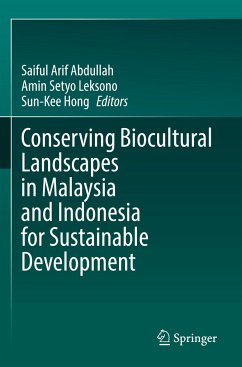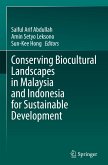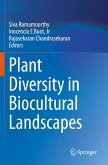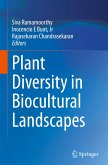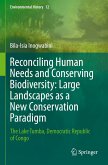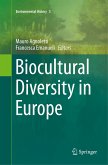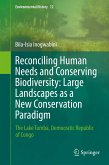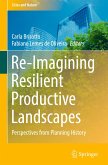Conserving Biocultural Landscapes in Malaysia and Indonesia for Sustainable Development
Herausgegeben:Abdullah, Saiful Arif; Leksono, Amin Setyo; Hong, Sun-Kee
Conserving Biocultural Landscapes in Malaysia and Indonesia for Sustainable Development
Herausgegeben:Abdullah, Saiful Arif; Leksono, Amin Setyo; Hong, Sun-Kee
- Broschiertes Buch
- Merkliste
- Auf die Merkliste
- Bewerten Bewerten
- Teilen
- Produkt teilen
- Produkterinnerung
- Produkterinnerung
This book presents perspective on the importance of natural and cultural relationships for conserving bio-cultural landscapes. It explores the approaches and concepts used to conserve bio-cultural landscapes in Malaysia and Indonesia. The book highlights the importance of bio-cultural landscape in sustainable development framework and its link to sustainable development goals are also included. It fills the gap in literature with special focus on this region.
The book is of interest to teachers, researchers, climate change scientists, conservationists, capacity builders and policymakers.…mehr
Andere Kunden interessierten sich auch für
![Conserving Biocultural Landscapes in Malaysia and Indonesia for Sustainable Development Conserving Biocultural Landscapes in Malaysia and Indonesia for Sustainable Development]() Conserving Biocultural Landscapes in Malaysia and Indonesia for Sustainable Development132,99 €
Conserving Biocultural Landscapes in Malaysia and Indonesia for Sustainable Development132,99 €![Plant Diversity in Biocultural Landscapes Plant Diversity in Biocultural Landscapes]() Plant Diversity in Biocultural Landscapes148,99 €
Plant Diversity in Biocultural Landscapes148,99 €![Plant Diversity in Biocultural Landscapes Plant Diversity in Biocultural Landscapes]() Plant Diversity in Biocultural Landscapes213,99 €
Plant Diversity in Biocultural Landscapes213,99 €![Reconciling Human Needs and Conserving Biodiversity: Large Landscapes as a New Conservation Paradigm Reconciling Human Needs and Conserving Biodiversity: Large Landscapes as a New Conservation Paradigm]() Bila-Isia InogwabiniReconciling Human Needs and Conserving Biodiversity: Large Landscapes as a New Conservation Paradigm160,49 €
Bila-Isia InogwabiniReconciling Human Needs and Conserving Biodiversity: Large Landscapes as a New Conservation Paradigm160,49 €![Biocultural Diversity in Europe Biocultural Diversity in Europe]() Biocultural Diversity in Europe110,99 €
Biocultural Diversity in Europe110,99 €![Reconciling Human Needs and Conserving Biodiversity: Large Landscapes as a New Conservation Paradigm Reconciling Human Needs and Conserving Biodiversity: Large Landscapes as a New Conservation Paradigm]() Bila-Isia InogwabiniReconciling Human Needs and Conserving Biodiversity: Large Landscapes as a New Conservation Paradigm110,99 €
Bila-Isia InogwabiniReconciling Human Needs and Conserving Biodiversity: Large Landscapes as a New Conservation Paradigm110,99 €![Re-Imagining Resilient Productive Landscapes Re-Imagining Resilient Productive Landscapes]() Re-Imagining Resilient Productive Landscapes108,99 €
Re-Imagining Resilient Productive Landscapes108,99 €-
-
-
This book presents perspective on the importance of natural and cultural relationships for conserving bio-cultural landscapes. It explores the approaches and concepts used to conserve bio-cultural landscapes in Malaysia and Indonesia. The book highlights the importance of bio-cultural landscape in sustainable development framework and its link to sustainable development goals are also included. It fills the gap in literature with special focus on this region.
The book is of interest to teachers, researchers, climate change scientists, conservationists, capacity builders and policymakers. Also it serves as additional reading material for undergraduate and graduate students of ecology, and environmental sciences. National and international environmental scientists, policy makers also find this to be a useful read.
The book is of interest to teachers, researchers, climate change scientists, conservationists, capacity builders and policymakers. Also it serves as additional reading material for undergraduate and graduate students of ecology, and environmental sciences. National and international environmental scientists, policy makers also find this to be a useful read.
Produktdetails
- Produktdetails
- Verlag: Springer / Springer Nature Singapore / Springer, Berlin
- Artikelnr. des Verlages: 978-981-16-7245-3
- 1st ed. 2022
- Seitenzahl: 248
- Erscheinungstermin: 4. April 2023
- Englisch
- Abmessung: 235mm x 155mm x 13mm
- Gewicht: 427g
- ISBN-13: 9789811672453
- ISBN-10: 9811672458
- Artikelnr.: 67566838
- Herstellerkennzeichnung Die Herstellerinformationen sind derzeit nicht verfügbar.
- Verlag: Springer / Springer Nature Singapore / Springer, Berlin
- Artikelnr. des Verlages: 978-981-16-7245-3
- 1st ed. 2022
- Seitenzahl: 248
- Erscheinungstermin: 4. April 2023
- Englisch
- Abmessung: 235mm x 155mm x 13mm
- Gewicht: 427g
- ISBN-13: 9789811672453
- ISBN-10: 9811672458
- Artikelnr.: 67566838
- Herstellerkennzeichnung Die Herstellerinformationen sind derzeit nicht verfügbar.
Saiful Arif Abdullah Dr. Saiful Arif Abdullah obtained his PhD from Hiroshima University, Japan. At present he is an Associate Professor at the Institute for Environment and Development (LESTARI), Universiti Kebangsaan Malaysia (UKM), Malaysia. His research interest includes landscape study of effects of land use changes on forested area and biocultural landscapes, forest fragmentation and their link to conservation planning and sustainability of protected area system. He has published his research works in several reputed international journals such as Ecological Indicators, Environmental Management and, Landscape and Urban Planning and chapters in book published by Springer and others. Amin Setyo Leksono Dr. Amin Setyo Leksono graduated from Graduate School for International Development and Cooperation, Hiroshima University, Hiroshima, Japan. Currently he is a Professor in the Department of Biology, Faculty of Mathematics and Natural Sciences, Brawijaya University in the field of Entomology and Ecology. He has more than 50 peer reviewed international publications and has delivered numerous oral presentations in several international meetings. He wrote five books in Indonesian and a chapter in Landscape Ecology for Sustainable Society published by Springer in 2017. Sun-Kee, Hong Dr. Sun-Kee Hong is professor at Institution for Marine & Island Cultures, Mokpo National University, Korea. He obtained his PhD in landscape ecology from Hiroshima University, Japan. His study fields are cultural landscape, island ecosystem and biocultural diversity management in Asian region. He recently published Landscape Ecology for Sustainable Society, Biocultural Landscapes and Landscape Ecology in Asian Cultures, all published by Springer. He is Editor-in-Chief of Journal of Marine and Island Cultures and a board member of International Association for Ecology. He is charge of editorial board in Ecological Research, Acta Ecologica Sinica, Landscape Ecology and Engineering, and Biological Indicator.
Chapter 1. Introduction: Context of the Book.- Chapter 2. Spreading a Concept of Biocultural Diversity: From the Perspective of Island and Seascape.- Chapter 3. Bioregion Concept for the Landscape of Traditional Village in West Sumba, East Nusa Tenggara, Indonesia.- Chapter 4. The Importance of Biocultural Landscape Concept in Managing Protected Area: A Case of Tasek Bera, Pahang State, Malaysian Peninsular.- Chapter 5. Bridge and Islandness: The Case of Suramadu Bridge in Indonesia.- Chapter 6. Sustainable GeoHeritage Tourism: Bridging GeoHeritage and Culture through the UNESCO Global Geopark Framework.- Chapter 7. The Role of Ecotourism in Biocultural Landscape to Harmonize Nature and Human towards Sustainable Development: Clungup Mangrove Conservation Area as a Case Study Chapter 8. Understanding Micro-experiences of Heritage Conservation in an Island-based Tourism Development: A Case of Kubang Badak BioGeo Trail, Langkawi Island, Kedah, Malaysia Chapter 9. The Dynamics of Environmental Change Pose Challenges to Preserving the Biocultural Landscape in Indonesia.- Chapter 10. Weaving the Semelai Knowledge-Practice-Belief: Traditional Ecological Knowledge and Farming in Tasek Bera, Pahang State, Peninsular Malaysia.- Chapter 11. Tagal System: A Biocultural Conservation Approach in Sabah, Malaysian Borneo.- Chapter 12. Empowerment Human Resources Through the Gender Development Index and Their Impact on Sustainable Development in the Rural Coastal Areas with Dynamic System and Multi-policy Model.- Chapter 13. Urban Green Space Planning and Management for Biocultural Diversity in Jakarta, Indonesia.- Chapter 14. A Review on the Direction of Future Studies on Biocultural Landscapes in Forest and Agroforestry Systems in Indonesia.- Chapter 15. Conserving Biocultural Landscapes: the Need for Sustainable Development.
Chapter 1. Introduction: Context of the Book.- Chapter 2. Spreading a Concept of Biocultural Diversity: From the Perspective of Island and Seascape.- Chapter 3. Bioregion Concept for the Landscape of Traditional Village in West Sumba, East Nusa Tenggara, Indonesia.- Chapter 4. The Importance of Biocultural Landscape Concept in Managing Protected Area: A Case of Tasek Bera, Pahang State, Malaysian Peninsular.- Chapter 5. Bridge and Islandness: The Case of Suramadu Bridge in Indonesia.- Chapter 6. Sustainable GeoHeritage Tourism: Bridging GeoHeritage and Culture through the UNESCO Global Geopark Framework.- Chapter 7. The Role of Ecotourism in Biocultural Landscape to Harmonize Nature and Human towards Sustainable Development: Clungup Mangrove Conservation Area as a Case Study Chapter 8. Understanding Micro-experiences of Heritage Conservation in an Island-based Tourism Development: A Case of Kubang Badak BioGeo Trail, Langkawi Island, Kedah, Malaysia Chapter 9. The Dynamics of Environmental Change Pose Challenges to Preserving the Biocultural Landscape in Indonesia.- Chapter 10. Weaving the Semelai Knowledge-Practice-Belief: Traditional Ecological Knowledge and Farming in Tasek Bera, Pahang State, Peninsular Malaysia.- Chapter 11. Tagal System: A Biocultural Conservation Approach in Sabah, Malaysian Borneo.- Chapter 12. Empowerment Human Resources Through the Gender Development Index and Their Impact on Sustainable Development in the Rural Coastal Areas with Dynamic System and Multi-policy Model.- Chapter 13. Urban Green Space Planning and Management for Biocultural Diversity in Jakarta, Indonesia.- Chapter 14. A Review on the Direction of Future Studies on Biocultural Landscapes in Forest and Agroforestry Systems in Indonesia.- Chapter 15. Conserving Biocultural Landscapes: the Need for Sustainable Development.

